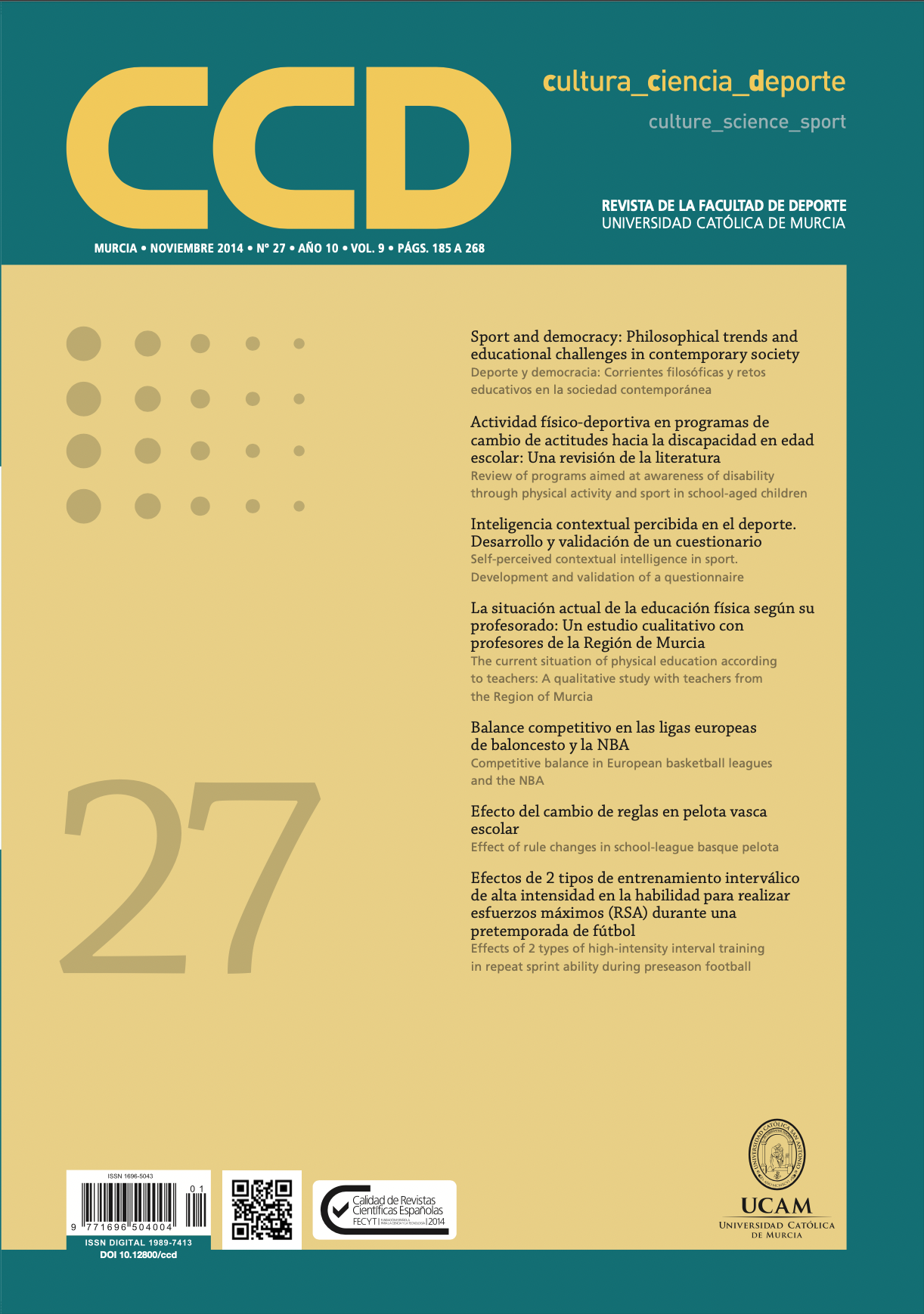Efectos de 2 tipos de entrenamiento interválico de alta intensidad en la habilidad para realizar esfuerzos máximos (RSA) durante una pretemporada de fútbol. (Effects of 2 types of high-intensity interval training in repeat sprint ability during preseason football).
DOI:
https://doi.org/10.12800/ccd.v9i27.467Resumen
http://dx.doi.org/10.12800/ccd.v9i27.467
El trabajo de pretemporada persigue mejorar el rendimientomdel futbolista tanto en lo referente a la habilidad para realizar esfuerzos máximos como a su capacidadmaeróbica y de recuperación. El objetivo de estemestudio fue comparar durante una pretemporada los efectos de 2 programas de entrenamiento interválicos con series de diferente duración en la habilidad de repetir sprints (RSA). Diecinueve jugadores de fútbol con valores medios ± SD de 20,9 ± 1,6 años de edad; 68,8 ± 5,1 Kg de peso; 176,1 ± 5,1 cm de altura; y 9,6 ± 2,4% de grasa corporal fueron asignados al azar al grupo de Speed Endurance Training (SET) para realizar 2x10 min con 10, 15 y 20 s al 100% con 30, 45 y 60 s de recuperación (n = 9), o al grupo High Interval Training (HIT) para realizar 4x4 min al 95% FCmax (n = 10). Un test RSA de 8x30 m con 25 s de recuperación activa fue realizado antes y después de la intervención (10 sesiones de entrenamiento) junto con un Yo-Yo Intermittent Recovery Test level 1 en la evaluación inicial. Tanto SET como HIT ven incrementado su rendimiento de forma significativa (p < 0,05) en RSAmejor (3,12% y 3,59% respectivamente) y muy significativamente (p < 0,01) en RSAmedia (3,00% y 3,91%) y RSAtotal (3,12% y 4,08%), pero sin cambios significativos en los índices de fatiga (Sdec y Change). Estos resultados demuestran que tanto la intervención SET como HIT se han mostrado útiles para aumentar el rendimiento en algunas de las variables determinantes en el test RSA, durante el periodo de pretemporada.
Palabras clave: Fatiga, resistencia a la velocidad, entrenamiento interválico de alta intensidad, pretemporada, fútbol.
===
Abstract
Preseason work aims to improve the performance of football players both in terms of the ability to perform maximal efforts and their aerobic and recovery capacity. The aim of this study was to compare the effects of 2 interval-training programs with series of different durations in repeat sprint ability (RSA). Nineteen football players with a mean (± SD) age of 20.95 ± 1.61 years; weight of 68.85 ± 5.15 kg; height of 176.11 ± 5.11 cm, and 9.61% ± 2.42% estimated body fat were randomly assigned to either a speed endurance training (SET) group to perform 2x10 min with 10, 15, and 20 s at 100% of HRmax and 30, 45, and 60 s of recovery (n = 9), respectively, or a highintensity interval training group to perform 4 × 4 min running at 95% of HRmax (n = 10). An 8x30 m RSA test with 25 s of active recovery was performed before and after the intervention (10 training sessions) along with the Yo-Yo Intermittent Recovery Test level 1 in the initial evaluation. Both the SET and HIT significantly improved performance (p < 0.05) for RSAbest (3.12% and 3.59%, respectively) and very significantly improved (p < 0.01) RSAmean (3.00% and 3.91%) and RSAtotal (3.12% and 4.08%), although no significant changes in fatigue index (Sdec y Change) were obtained. These results demonstrate that both the SET and HIT interventions have proved useful to increase performance in some of the key variables in the RSA test during the preseason.
Key words: Fatigue, speed endurance, high interval training, preseason, football.
Descargas
Cómo citar
Número
Sección
Licencia
Los autores que publican en esta revista están de acuerdo con los siguientes términos:- Los autores conservan los derechos de autor y garantizan a la revista el derecho de ser la primera publicación del trabajo al igual que licenciado bajo una Creative Commons Attribution License que permite a otros compartir el trabajo con un reconocimiento de la autoría del trabajo y la publicación inicial en esta revista.














